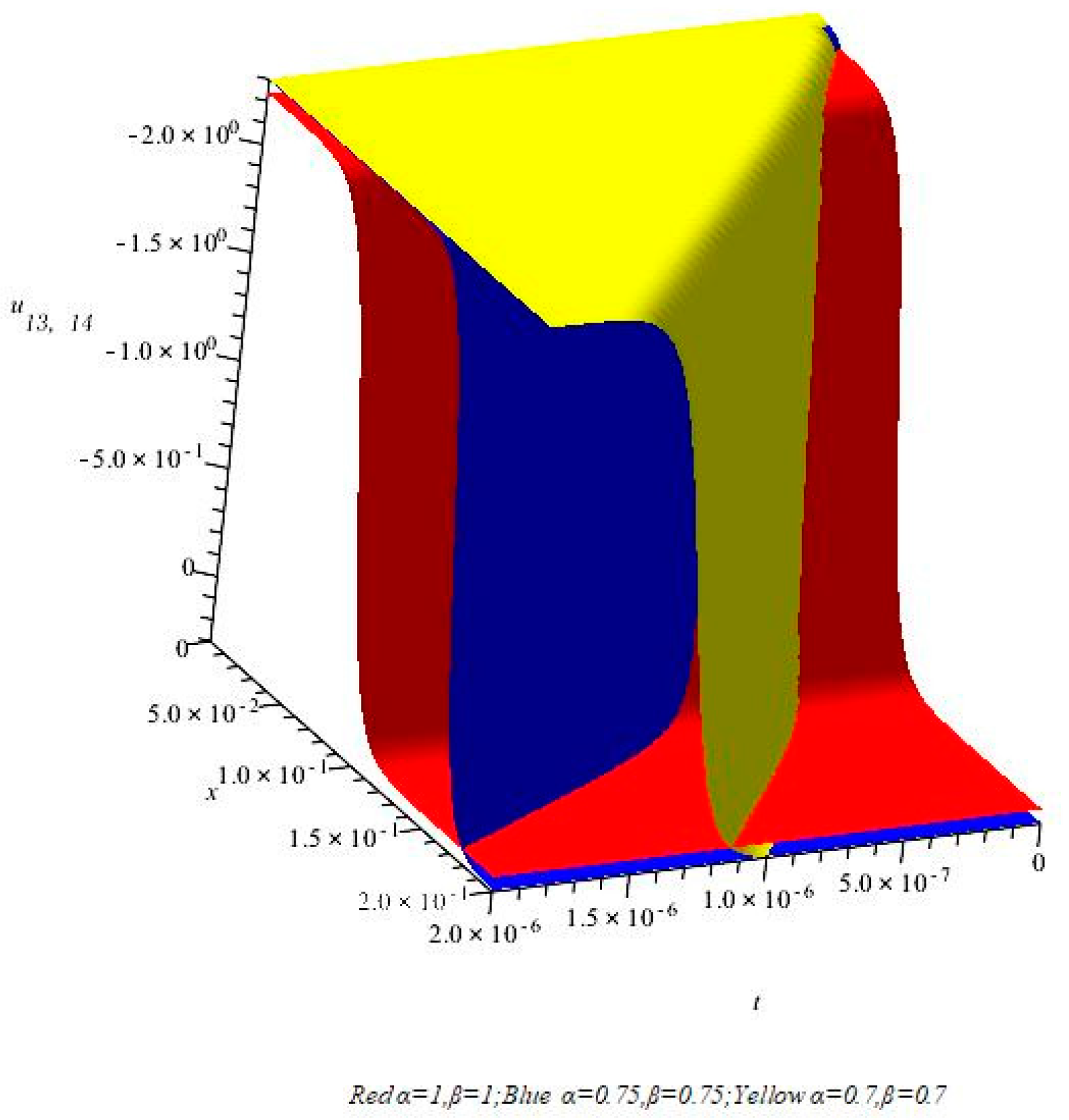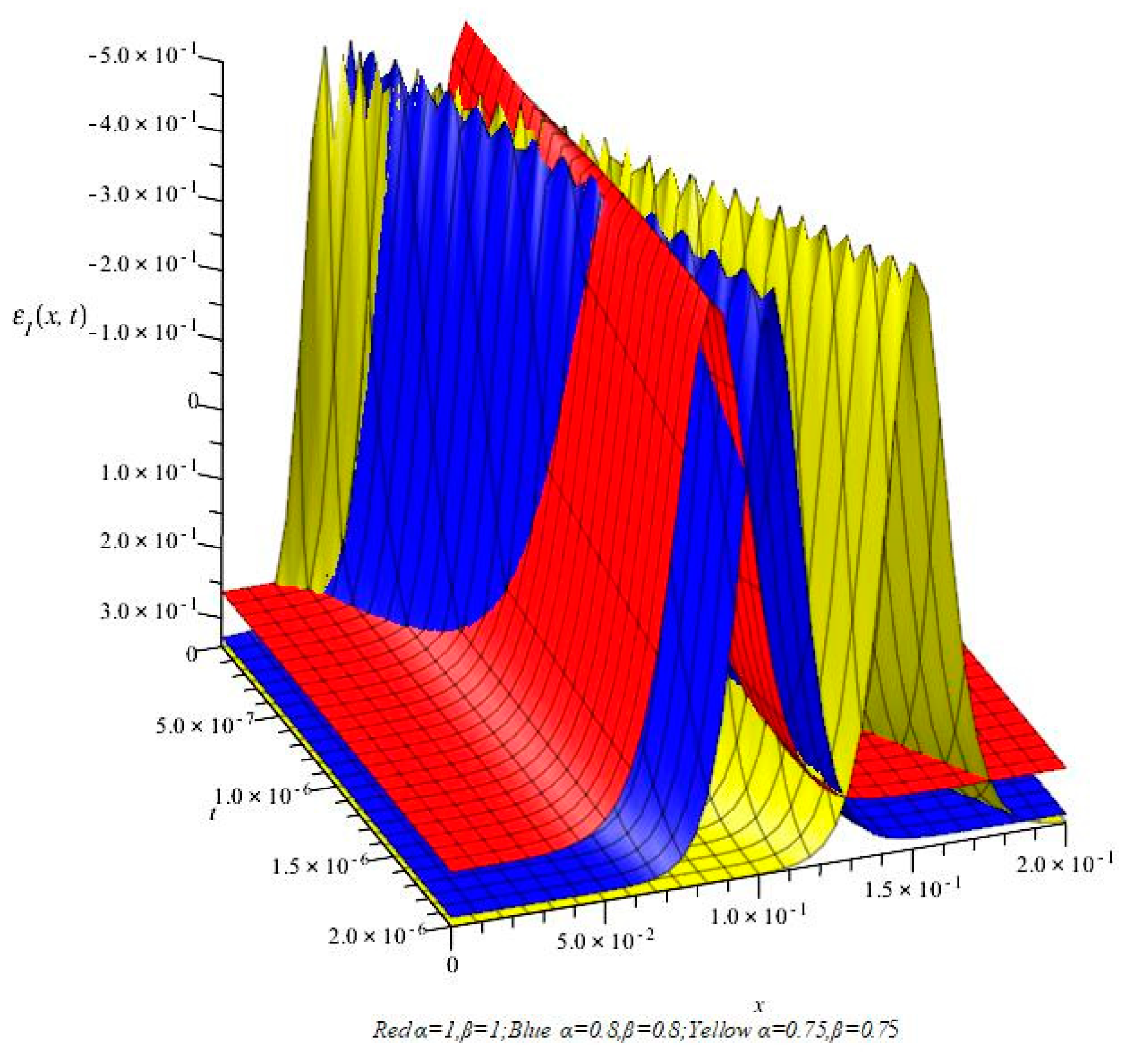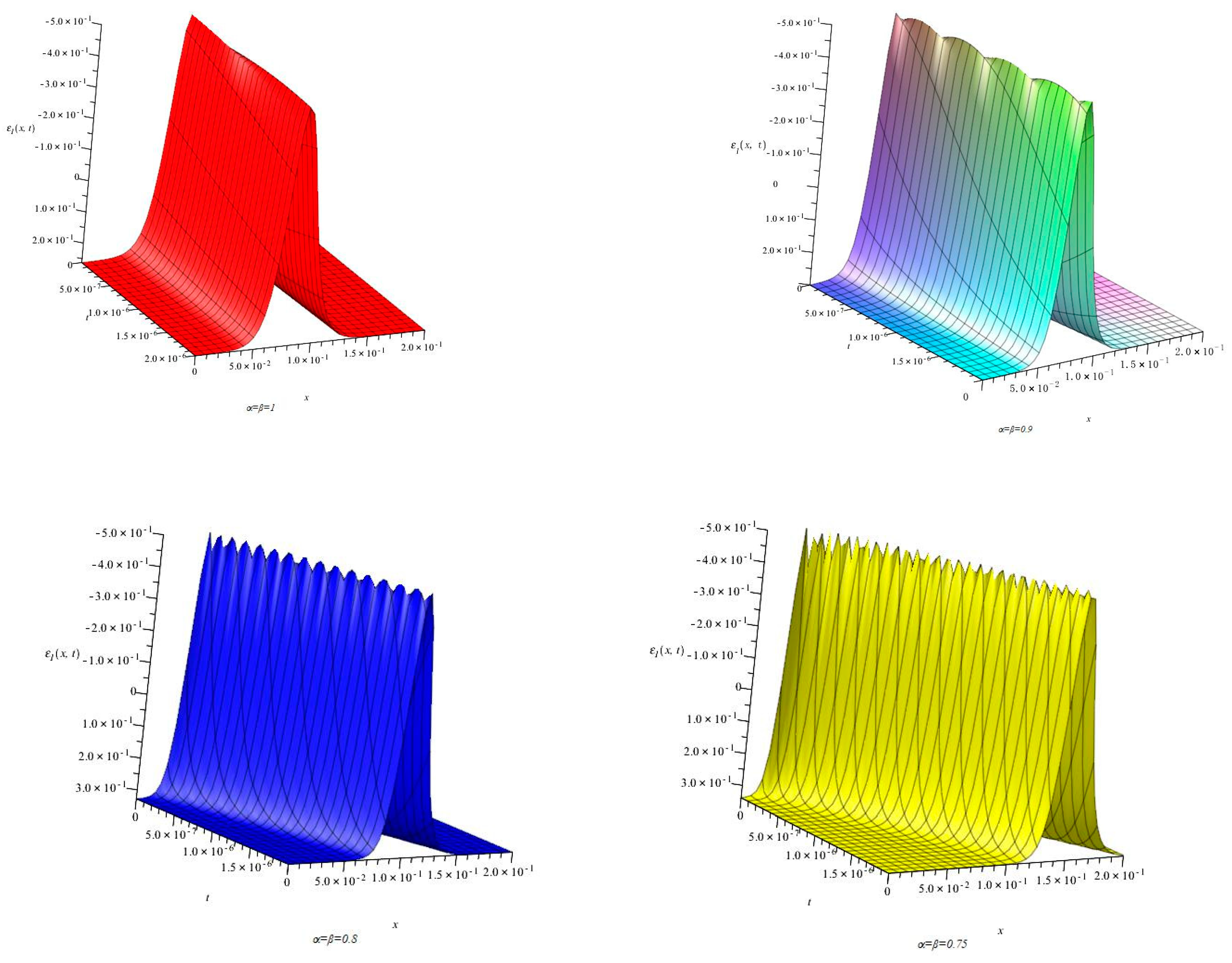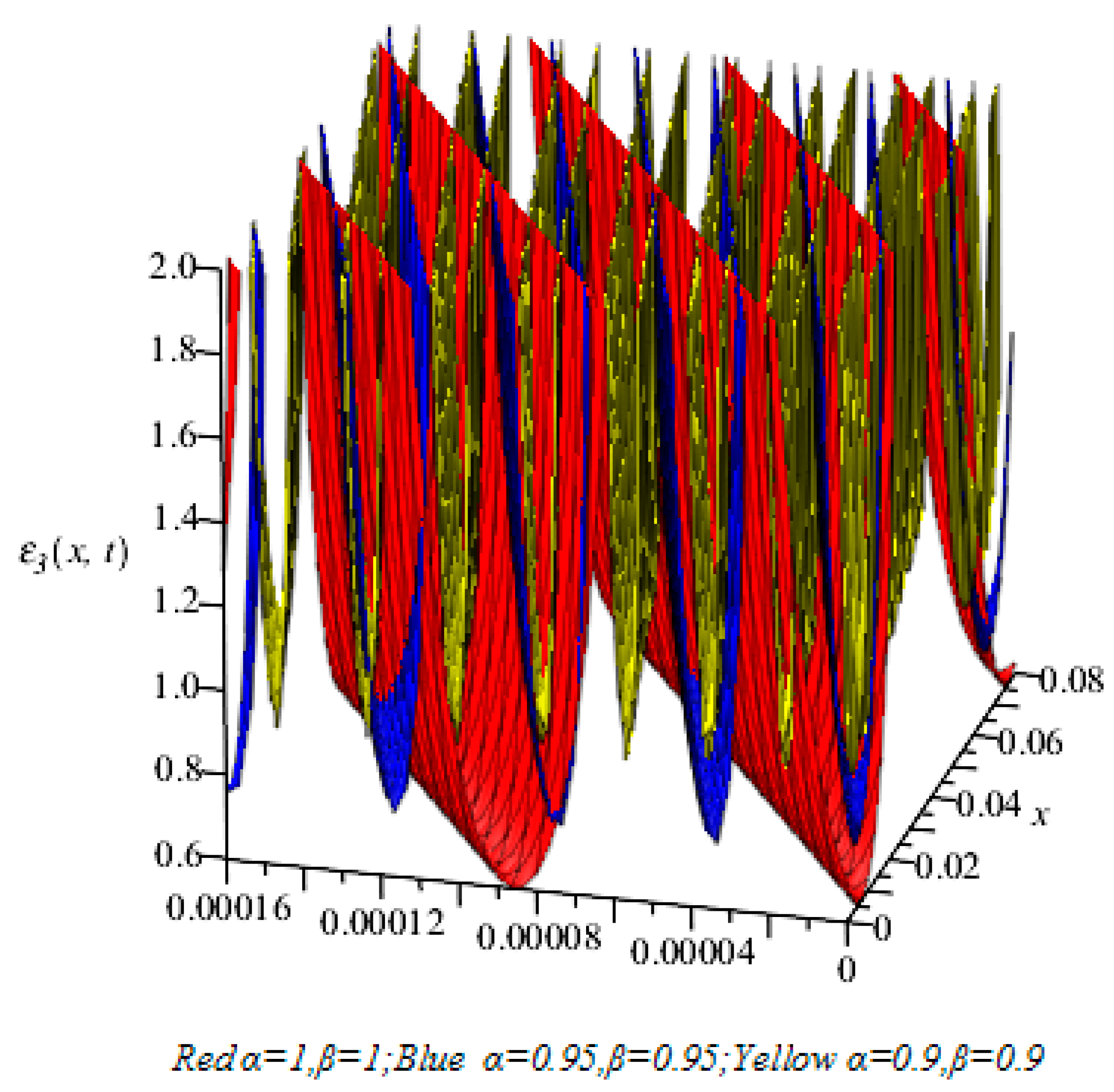Evolution Analysis of Strain Waves for the Fractal Nonlinear Propagation Equation of Longitudinal Waves in a Rod
Abstract
:1. Introduction
- Based on the layered and porous characteristics of functionally graded materials, a fractal nonlinear propagation equation for longitudinal waves in a functionally graded rod is established for the first time using fractal derivatives. Due to the joint intervention of nonlinearity and fractal, the derivation of the longitudinal wave propagation equation in the rod is more technical.
- An equivalent simplified extension (G′/G) expansion method is proposed and used to obtain the exact displacement gradient traveling wave solution of the fractal nonlinear propagation equation of longitudinal waves in the functional gradient rod. This equivalent simplification makes the solution process more concise.
- By comparing and discussing all the exact solutions obtained and analyzing the mechanism of the solution method, it is clarified which forms of exact solutions of the nonlinear wave equation can be obtained by the extended (G′/G) expansion method. This makes the understanding of the extended (G’ G) expansion method more profound.
- Through numerical simulation, the evolution law of three kinds of fractal dimension strain waves in functionally graded rods with space-time fractal dimension is shown, and the performance requirements of the materials when the strain waves propagate in functionally graded materials are found. This makes the presentation of the conclusion more intuitive.
2. Fractal Nonlinear Propagation Equation of Longitudinal Waves in a Rod
3. Exact Displacement Gradient Traveling Wave Solutions of the Fractal Nonlinear Longitudinal Wave Propagation Equation
- (1)
- When h < 0, using Equation (8) or Equation (9), the exact hyperbolic function solutions of Equation (7) are obtained as follows.
- (2)
- When h > 0, using Equation (8) or Equation (9), the exact solution of the trigonometric function of Equation (7) is obtained as follows.
- (3)
- When h = 0, then b1 = 0, the rational solution of Equation (7) is
- (1)
- When h < 0, using Equation (8) or Equation (9), the exact hyperbolic function solutions of Equation (7) are obtained as follows.
- (2)
- When h > 0, using Equation (8) or Equation (9), the exact solution of the trigonometric function of Equation (7) is obtained as follows.
- (3)
- When h = 0, then , the solution is the previous solution .
- (1)
- When h < 0, using Equation (8) or Equation (9), the exact hyperbolic function solutions of Equation (7) are obtained as follows.
- (2)
- When h > 0, using Equation (8) or Equation (9), the exact solution of the trigonometric function of Equation (7) is obtained as follows.
- (3)
- When h = 0, the solution is the previous solution .
- (1)
- When h < 0, using Equation (8) or Equation (9), the exact hyperbolic function solutions of Equation (7) are obtained as follows.
- (2)
- When h > 0, using Equation (8) or Equation (9), the exact solution of the trigonometric function of Equation (7) is obtained as follows.
- (3)
- When h = 0, then b1 = 0, the solution degenerates into a constant.
4. Discussion of Exact Solution and Solving Method
4.1. Comparative Discussion of Exact Displacement Gradient Solutions
4.2. Theoretical Analysis of Comparative Discussion Results of Exact Displacement Gradient Solutions
5. Fractal Dimension Nonlinear Strain Wave and Numerical Simulation
5.1. Existence Analysis of Exact Displacement Gradient Solutions
5.2. Numerical Simulation Analysis of u13,14 and Its Corresponding Fractal Dimension Bell-Shaped Strain Solitary Wave
5.3. Numerical Simulation Analysis of Fractal Dimension Strain Blasting Wave Based on u21,22
5.4. Numerical Simulation Analysis of Fractal Dimension Strain Periodic Wave Based on u3,4
6. Conclusions
Author Contributions
Funding
Data Availability Statement
Conflicts of Interest
References
- Minoo, N.; Kamyar, S. Functionally graded materials: A review of fabrication and properties. Appl. Mater. Today 2016, 5, 223–245. [Google Scholar]
- Barbaros, I.; Yang, Y.; Safaei, B.; Yang, Z.; Qin, Z.; Asmael, M. State-of-the-art review of fabrication, application, and mechanical properties of functionally graded porous nanocomposite materials. Nanotechnol. Rev. 2022, 11, 321–371. [Google Scholar] [CrossRef]
- Gupta, S.; Bhengra, N. Study of the surface wave vibrations in a functionally graded material layered structure: A WKB method. Math. Mech. Solids 2019, 24, 1204–1220. [Google Scholar] [CrossRef]
- Kiełczyński, P.; Szalewski, M.; Balcerzak, A.; Wieja, K. Propagation of ultrasonic Love waves in nonhomogeneous elastic functionally graded materials. Ultrasonics 2015, 65, 220–227. [Google Scholar] [CrossRef]
- Chen, W.Q.; Wang, H.M.; Bao, R.H. On calculating dispersion curves of waves in a functionally graded elastic plat. Compos. Struct. 2007, 81, 233–242. [Google Scholar] [CrossRef]
- Lee, J.C.; Ahn, S.H. Bulk Density Measurement of Porous Functionally Graded Materials. Int. J. Precis. Eng. Man. 2018, 19, 31–37. [Google Scholar] [CrossRef]
- Wu, H.L.; Yang, J.; Kitipornchai, S. Mechanical analysis of functionally graded porous structures: A review. Int. J. Struct. Stab. Dyn. 2020, 20, 2041015. [Google Scholar] [CrossRef]
- Shafiei, N.; Kazemi, M. Buckling analysis on the bidimensional functionally graded porous tapered nano-micscale beams. Aerosp. Sci. Technol. 2017, 66, 1–11. [Google Scholar] [CrossRef]
- Akbas, S.D. Forced vibration analysis of functionally graded porous deep beams. Compos. Struct. 2018, 186, 293–302. [Google Scholar] [CrossRef]
- Mesbaha, A.; Belabed, Z.; Amara, K.; Tounsi, A.; Bousahla, A.A.; Bourada, F. Formulation and evaluation a finite element model for free vibration and buckling behaviours of functionally graded porous (FGP) beams. Struct. Eng. Mech. 2023, 86, 291–309. [Google Scholar]
- Katiyar, V.; Gupta, A.; Tounsi, A. EMicrostructural/geometric imperfection sensitivity on the vibration response of geometrically discontinuous bi-directional functionally graded plates (2D-FGPs) with partial supports by using FEM. Steel Compos. Struct. 2022, 45, 621–640. [Google Scholar]
- He, J.H. Fractal calculus and its geometrical explanation. Results Phys. 2018, 10, 272–276. [Google Scholar] [CrossRef]
- He, J.H. A new fractal derivation. Therm. Sci. 2011, 15, 145–147. [Google Scholar] [CrossRef]
- He, J.H.; Ain, Q.T. New promises and future challenges of fractal calculus from two-scale thermodynamics to fractal variational principle. Therm. Sci. 2020, 24, 659–681. [Google Scholar] [CrossRef]
- Lin, Y.Q.; Feng, J.W.; Zhang, C.C.; Teng, Y.; Liu, Z.; He, J.H. Air permeability of nanofiber membrane with hierarchical structure. Therm. Sci. 2018, 22, 1637–1643. [Google Scholar]
- Li, X.X.; Tian, D.; He, C.H.; He, J.H. A fractal modification of the surface coverage model for an electrochemical arsenic sensor. Electrochim. Acta 2019, 296, 491–493. [Google Scholar] [CrossRef]
- Wang, Q.; Shi, X.; He, J.H.; Li, Z.B. Fractal Calculus and its Application to Explanation of Biomechanism of Polar Bear Hairs. Fractals 2018, 26, 1850086. [Google Scholar] [CrossRef]
- Wang, Y.; Deng, Q. Fractal derivative Model for Tsunami Travelling. Fractals 2019, 27, 1950017. [Google Scholar] [CrossRef]
- Yan, W.; An, J.Y. Amplitude-frequency relationship to a fractional Duffing oscillator arising in microphysics and tsunami motion. J. Low Freq. Noise Vib. Act. Control. 2019, 38, 1008–1012. [Google Scholar]
- Liu, Z.F.; Zhang, S.Y. Three Kinds of Nonlinear Dispersive Waves in Elastic Rods with Finite Deformation. Appl. Math. Mech. 2008, 29, 909–917. [Google Scholar]
- Liu, J.K.; Wei, W.; Wang, J.B.; Xu, W. Limit behavior of the solution of Caputo-Hadamard fractional stochastic differential equations. Appl. Math. Lett. 2023, 140, 108586. [Google Scholar] [CrossRef]
- Liu, J.K.; Wei, W.; Xu, W. An averaging principle for stochastic fractional differential equations driven by fBm involving impulses. Fractal. Fract. 2022, 6, 256. [Google Scholar] [CrossRef]
- Khan, K.; Akba, M.A.; Salam, M.A.; Islam, M.H. A note on enhanced (G’/G)-expansion method in nonlinear physics. Ain. Shams Eng. J. 2014, 5, 877–884. [Google Scholar] [CrossRef] [Green Version]
- Shahzad, S. New soliton wave structures of nonlinear (4 + 1)-dimensional Fokas dynamical model by using different methods. Alex. Eng. J. 2021, 60, 795–803. [Google Scholar]
- Ullah, N.; Asjad, M.I.; Awrejcewicz, J.; Muhammad, T.; Baleanu, D. On soliton solutions of fractional-order nonlinear model appears in physical sciences. AIMS Math. 2022, 7, 7421–7440. [Google Scholar] [CrossRef]
- Jiang, Z.; Zhang, Z.G.; Li, J.J.; Yang, H.W. Analysis of Lie Symmetries with Conservation Laws and Solutions of Generalized (4 + 1)-Dimensional Time-Fractional Fokas Equation. Fractal. Fract. 2022, 6, 108. [Google Scholar] [CrossRef]
- Hu, X.R.; Lin, S.N.; Wang, L. Integrability, multiple-cosh, lumps and lump-soliton solutions to a (2 + 1)-dimensional generalized breaking soliton equation. Commun. Nonlinear Sci. 2020, 91, 105447. [Google Scholar] [CrossRef]
- Gardner, C.S.; Greene, J.M.; Kruskal, M.D.; Miura, R.M. Method for solving the Kortweg-de Vries equation. Phys. Rev. Lett. 1967, 19, 1095–1097. [Google Scholar] [CrossRef]
- Malfliet, W. Solitary wave solutions of nonlinear wave equations. Am. J. Phys. 1992, 60, 650–654. [Google Scholar] [CrossRef]
- Fan, E.G. Extended tanh-function method and its applications to nonlinear equations. Phys. Lett. A 2000, 277, 212–218. [Google Scholar] [CrossRef]
- Khuri, S.A. A complex tanh-function method applied to nonlinear equations of Schrödinger typ. Chaos Soliton. Fract. 2004, 20, 1037–1040. [Google Scholar] [CrossRef]
- Elwakil, S.A.; Labany, S.K.; Zahran, M.A.; Sabry, R. Modified extended tanh-function method and its applications to nonlinear equations. Appl. Math. Comput. 2005, 161, 403–412. [Google Scholar] [CrossRef]
- Liu, S.K.; Fu, Z.T.; Liu, S.D. Jacobi elliptic function expansion method and periodic wave solutions of nonlinear wave equations. Phys. Lett. A 2001, 289, 69–74. [Google Scholar] [CrossRef]
- Chen, H.T.; Zhang, H.Q. Improved Jacobi elliptic function method and its applications. Chaos Soliton. Fract. 2003, 15, 585–591. [Google Scholar] [CrossRef]
- Wang, Q.; Chen, Y.; Zhang, H.Q. A new Jacobi elliptic function rational expansion method and its application to (1 + 1)-dimensional dispersive long wave equation. Chaos Soliton. Fract. 2005, 23, 477–483. [Google Scholar] [CrossRef]
- Yomba, E. The extended F-expansion method and its application for solving the nonlinear wave, CKGZ, GDS, DS and GZ equations. Phys. Lett. A 2005, 340, 149–160. [Google Scholar] [CrossRef]
- Kudryashov, N.A.; Loguinova, N.B. Be careful with the exp-function method. Commun. Nonlinear Sci. 2009, 14, 1881–1890. [Google Scholar] [CrossRef] [Green Version]
- Kudryashov, N.A. One method for finding exact solutions of nonlinear differential equations. Commun. Nonlinear Sci. 2012, 17, 2248–2253. [Google Scholar] [CrossRef] [Green Version]
- Sirendaoreji. Unified Riccati equation expansion method and its application to two new classes of Benjamin-Bona-Mahony equations. Nonlinear Dynam. 2017, 89, 333–344. [Google Scholar] [CrossRef]
- Yue, C.; Lu, D.C.; Khater, M.M.A. On explicit wave solutions of the fractional nonlinear DSW system via the modified Khater method. Fractals 2020, 28, 204034. [Google Scholar] [CrossRef]
- Guo, P.; Tang, R.G.; Sun, X.W. Explicit exact solutions to the wave equation for nonlinear elastic rods. Appl. Math. Mech. 2022, 43, 869–875. [Google Scholar]
- Wang, M.L.; Li, X.Z.; Zhang, J.L. The (G’/G)-expansion method and travelling wave solutions of nonlinear evolution equations in mathematical physics. Phys. Let. A 2008, 372, 417–423. [Google Scholar] [CrossRef]
- Ekici, M.; Mirzazadeh, M.; Eslami, M. Solitons and other solutions to Boussinesq equation with power law nonlinearity and dual dispersion. Nonlinear Dynam. 2016, 84, 669–676. [Google Scholar] [CrossRef]
- Khatuna, M.A.; Arefin, M.A.; Uddin, M.H.; Baleanu, D.; Akbar, M.A.; Inc, M. Explicit wave phenomena to the couple type fractional order nonlinear evolution equations. Results Phys. 2021, 28, 104597. [Google Scholar] [CrossRef]
- Ali, M.N.; Husnine, S.M.; Saha, A.; Bhowmik, S.K.; Dhawan, S.; Ak, T. Exact solutions, conservation laws, bifurcation of nonlinear and supernonlinear traveling waves for Sharma-Tasso-Olver equation. Nonlinear Dynam. 2018, 94, 1791–1801. [Google Scholar] [CrossRef]
- Kaplan, M.; Ünsal, Ö.; Bekir, A. Exact solutions of nonlinear Schrödinger equation by using symbolic computation. Math. Method. Appl. Sci. 2016, 39, 2093–2099. [Google Scholar] [CrossRef]
- Bibi, S.; Mohyud, D.S.T.; Ullah, R.; Ahmed, N.; Khan, U. Exact solutions for STO and (3 + 1)-dimensional KdV-ZK equations using (G’/G2)-expansion method. Results Phys. 2017, 7, 4434–4439. [Google Scholar] [CrossRef]
- Pang, J.; Bian, C.Q. A new auxiliary equation method for finding travelling wave solutions to KdV equation. Appl. Math. Mech. 2010, 33, 929–936. [Google Scholar] [CrossRef]
- Fan, K.; Zhou, C.L. Mechanical Solving a Few Fractional Partial Differential Equations and Discussing the Effects of the Fractional Order. Adv. Math. Phys. 2020, 2020, 3758353. [Google Scholar] [CrossRef]
- Jia, H.X.; Zuo, D.W.; Tian, X.S.; Guo, Z.F. Characteristics of coexisting rogue wave and breather in vector nonlinear Schrödinger system. Appl. Math. Lett. 2023, 136, 108461. [Google Scholar] [CrossRef]
- Bukhari, M.A.; Barry, O.R.; Vakakis, A.F. Breather propagation and arrest in a strongly nonlinear locally resonant lattice. Mech. Syst. Signal Pr. 2023, 183, 109623. [Google Scholar] [CrossRef]
- Zhong, W.P.; Yang, Z.P.; Milivoj, B.; Zhong, W.Y. Rogue wave excitations of the (2 + 1)-dimensional nonlinear Zakharov system. Nonlinear Dynam. 2023, 111, 6621–6628. [Google Scholar]
- Chen, W. Time-space fabric underlying anomalous diffusion. Chaos Soliton. Fract. 2006, 28, 923–929. [Google Scholar]
- Chen, W.; Liang, Y.J. New methodologies in fractional and fractal derivatives modeling. Chaos Soliton. Fract. 2017, 102, 72–77. [Google Scholar] [CrossRef]





| Nonexistent Solution | Solution of Existence | Existence Condition | Existence and Same Solutions | Existence and Different Solutions |
|---|---|---|---|---|
Disclaimer/Publisher’s Note: The statements, opinions and data contained in all publications are solely those of the individual author(s) and contributor(s) and not of MDPI and/or the editor(s). MDPI and/or the editor(s) disclaim responsibility for any injury to people or property resulting from any ideas, methods, instructions or products referred to in the content. |
© 2023 by the authors. Licensee MDPI, Basel, Switzerland. This article is an open access article distributed under the terms and conditions of the Creative Commons Attribution (CC BY) license (https://creativecommons.org/licenses/by/4.0/).
Share and Cite
Fan, K.; Liu, J.; Wang, J.; Jin, C. Evolution Analysis of Strain Waves for the Fractal Nonlinear Propagation Equation of Longitudinal Waves in a Rod. Fractal Fract. 2023, 7, 586. https://doi.org/10.3390/fractalfract7080586
Fan K, Liu J, Wang J, Jin C. Evolution Analysis of Strain Waves for the Fractal Nonlinear Propagation Equation of Longitudinal Waves in a Rod. Fractal and Fractional. 2023; 7(8):586. https://doi.org/10.3390/fractalfract7080586
Chicago/Turabian StyleFan, Kai, Jiankang Liu, Jinbin Wang, and Chen Jin. 2023. "Evolution Analysis of Strain Waves for the Fractal Nonlinear Propagation Equation of Longitudinal Waves in a Rod" Fractal and Fractional 7, no. 8: 586. https://doi.org/10.3390/fractalfract7080586




